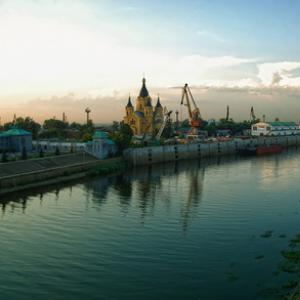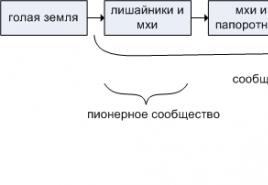The process of succession is characterized. Secondary successions. Succession. Examples of ecosystem succession
Ecological succession is a process of consistent directed development of an ecosystem, from simple to complex and more stable.
Succession in an ecosystem is most visibly manifested in a change in vegetation - in a change in species composition and the replacement of some dominants by others. Vegetation changes will be different depending on the type of succession, the completeness of the ecosystem, its position in the relief and the type of anthropogenic load.
Successions are divided into two types - primary And secondary. Primary succession is the development of an ecosystem from a zero state, when all components are formed on the freed surface - plant and animal communities, a complex of microorganisms, soil. Secondary succession refers to such changes when one or more components are disrupted and the ecosystem returns to its original state or shifts in some new direction. Ecosystems undergoing succession may have different numbers of initial components. They can be full members- with a complete set of components - or incomplete when one or more components are missing.
Example primary succession may serve as primary and secondary overgrowth of dumps; secondary succession in an incomplete ecosystem - overgrowing of fallow lands - and secondary successions in a complete ecosystem - post-hay demutation and development of seeded grass mixture.

Primary succession scheme
As parameters characterizing the course of succession, the indicator of similarity and the phytocenotic structure of the species composition, the share of species of different phytocenotic groups in the composition of the community phytomass, and the distribution of species among abundance groups are used.
Phytocenotic groups include weed species characteristic of the initial stages of succession, fallow species that dominate at intermediate stages, and terminal species, i.e. species that make up zonal uninfested communities - steppe, meadow-steppe, meadow, meadow-forest, forest, meadow-swamp, swamp. Plants of tropical forests have a much greater diversity of phytocenotic groups.
Different metrics describe different community structures and change in different ways during succession. By the proximity of their quantitative values to the parameters characterizing the terminal stages, one can judge the speed and progress of succession and the similarity of vegetation trends in different successional series.
Simultaneously with vegetation succession, significant changes occur in the autotrophic part of the biological cycle. During primary succession, reserves of green photosynthetic phytomass and underground organs, including tillering nodes, roots, rhizomes, bulbs, and tubers, are created, and during secondary succession, reserves are transformed. A change in dominants leads to qualitative and quantitative changes in the composition of aboveground and underground phytomass. When the phytomass dies, mortmass is formed - rags and litter in the above-ground part of the phytocenosis, root plant residues - in the underground. A change in the structure of plant matter is as characteristic of succession as a change in the vegetation itself.
The final stage of succession development is the climax community, which is characterized by the fact that per unit of energy flow there is a maximum biomass and a maximum number of interspecific interactions.
Microbial community, etc.) to others in a certain area of the environment over time.
The theory of succession was initially developed by geobotanists, but then began to be widely used by other ecologists. One of the first to develop the theory of succession was F. Clements and developed it by V. N. Sukachev, and then by S. M. Razumovsky.
The term was introduced by F. Clements to designate communities that replace each other over time, forming succession series (series), where each previous stage ( serial community) forms the conditions for the development of the subsequent one. If no events causing a new succession occur, then the series ends with a relatively stable community that has a balanced exchange given the given environmental factors. F. Clements called such a community climax. The only sign of menopause in the sense of Clements-Razumovsky is the absence of internal reasons for change. The time of existence of a community cannot in any case be one of the indicators.
Although the terms introduced by Clements are widely used, there are two fundamentally different paradigms within which the meaning of these terms is different: continualism And structuralism. Supporters of structuralism develop Clements' theory, supporters of continuum, in principle, reject the reality of communities and successions, considering them stochastic phenomena and processes (polyclimax, climax-continuum). The processes occurring in the ecosystem in this case are simplified to the interaction of species encountered at random and the abiotic environment. The continuum paradigm was first formulated by the Soviet geobotanist L. G. Ramensky (-) and, independently of him, by the American geobotanist G. Gleason (-).
Classification
There are many classifications of successions, according to indicators that can change during succession or for reasons of change:
- by time scale (fast, medium, slow, very slow),
- by reversibility (reversible and irreversible),
- according to the degree of process constancy (constant and non-constant),
- by origin (primary and secondary),
- by trends in productivity changes (progressive and regressive),
- according to the trend of changes in species richness (progressive and regressive),
- by anthropogenicity (anthropogenic and natural),
- by the nature of the changes occurring during succession (autotrophic and heterotrophic).
Depending on the goals of the researcher, such classifications can be built on any logical basis, and their number can be increased indefinitely. For example, P. D. Yaroshenko () pointed out the need to divide anthropogenic shifts into shifts in socialist countries and shifts in capitalist countries.
If we classify successions on the basis of ongoing processes, then we can distinguish two main groups: endogenous, occurring as a result of the functioning of communities, and exogenous, occurring as a result of external influences. The driving force behind endogenous successions is the unbalanced exchange of communities.
Primary
A well-known example of primary succession is the settlement of hardened lava after a volcanic eruption or a slope after an avalanche that destroyed the entire soil profile. Now such phenomena are rare, but every landmass at some time went through primary succession.
Primary successions develop in parallel with soil formation under the influence of the constant entry of seeds from outside, the death of seedlings unstable to extreme conditions, and only from a certain time - under the influence of interspecific competition. The development of one or another serial community and its replacement are determined mainly by the nitrogen content in the soil and the degree of destruction of its mineral part.
For example, for the mountainous areas of Alaska, the following typical stages of primary succession with characteristic dominant plants are distinguished:
- Lichens destroy the rock and enrich it with nitrogen.
- Mosses and a number of herbs.
- and you .
- Alder-dominated shrub communities.
Secondary
A spruce forest destroyed after a fire is usually cited as an example of secondary succession. In the territory it previously occupied, soil and seeds were preserved. The herbaceous community will be formed the following year. Further options are possible: in a humid climate, rush grass dominates, then it is replaced by raspberries, which is replaced by aspen; in dry climates, reed grass predominates, it is replaced by rose hips, and rose hips by birch. Under the cover of an aspen or birch forest, spruce plants develop, eventually displacing deciduous trees. Restoration of a dark coniferous forest occurs in approximately 100 years. Restoration of climax oak forests in the Moscow region usually does not occur, since the forest is again cut down. Secondary successions after fires in the forest-tundra and northern taiga are considered in detail in the works of A.P. Tyrtikov. birch forests. They take turns mixed green moss forests 120-150 years after the fire. Rare mixed sphagnum forests replaced by mixed green moss forests 200-250 years after the fire. Open woodlands on sphagnum bogs are formed on the site of sparse sphagnum forests after 250-300 years. And after 300-350 years shrub-lichen tundras give way to open forests on sphagnum bogs.
Succession in microbiology
In natural (e.g., soil) microbial communities, succession is usually caused by the supply of organic matter of one form or another. Since various microorganisms are adapted to either break down complex polymers, absorb monomers at high concentrations, or survive in starvation conditions, changes in community structure occur as organic matter is broken down and used.
In the forest floor, for example, it is possible to study several stages of succession simultaneously as they change from top to bottom.
In addition, succession can be caused by changes in temperature, humidity, content of gases or specific substances, etc. The process of soil formation is accompanied by long-term succession of both plant and microbial communities.
see also
- Variability of biocenosis
- Environmental strategies
Notes
| Ecosystem | |
|---|---|
| Ecosystems | Land ecosystems Marine ecosystems Freshwater ecosystems Types of ecosystems Biogeocenosis Biome Biosphere Natural territorial complex Artificial ecosystems |
| Functional components | Producers (autotrophs) Consumers Decomposers |
| Structural Components | Zoocenosis · Phytocenosis · Biocenosis · Sinusia · Price cell · Edifier · Consortium |
| Abiotic components | Biogenic elements · Microclimate · Physical factors · Habitat (Biotope, Station) · Ecotope · Climatope · |
| Operation | succession· Succession · Ecosystem degradation · Ecosystem evolution |
| Ecosystem pollution | |
The process by which communities of plant and animal species are replaced over time by other, usually more complex, communities is called ecological succession, or simply succession. Ecological succession usually continues until the community becomes stable and self-sustaining. The final community that occupies the disturbed area is called a mature community, and the ecosystem as a whole is called climax. There are several large terrestrial climax ecosystems on the planet, which are called biomes: tundra, coniferous forests (taiga), temperate forests, steppes, deserts, savannas, tropical rain forests.
Succession and its stages.
Ecologists distinguish two types of ecological succession: primary and secondary. Primary succession is the consistent development of communities in areas lacking soil.
The more common type of succession is secondary succession, i.e. the successive development of communities in an area in which natural vegetation has been eliminated or severely disturbed, but the soil has not been destroyed.
There are two extreme types of species strategies - r-strategy and K-strategy. These are two different solutions to the same problem - the problem of long-term survival of the species.
Species with an r-strategy are quicker to colonize disturbed habitats characteristic of the early stages of succession, such as exposed rock, forest clearings, and burnt areas, than species with a K-strategy, since they spread more easily and reproduce faster.
Species with a K-strategy are more competitive and eventually displace r-species, which meanwhile move to other disturbed habitats.
Succession of any scale ends with the formation of a mature community, and in the ecosystem all populations come to a state of dynamic equilibrium.
During succession, species diversity gradually increases.
From an energy standpoint, succession is an unstable state of a community that is characterized by a discrepancy between two indicators: gross productivity and the energy costs of the entire system to maintain life—respiration.
By removing excess net production from communities at the beginning of succession, we delay it, but do not undermine the basis of the community’s existence.
Intervention in stable, climax systems inevitably causes a disruption of the existing balance. As long as the disturbance does not exceed the self-healing capacity of the system, secondary successions can return it to its original state - this is used, for example, when planning forest cuttings.
Human influence on natural ecosystems.
Human activity is an anthropogenic factor and its impact on ecosystems. Reduction in the diversity of species, the number of species due to the extermination of individuals, changes in their habitat. In connection with this, a decrease in the diversity of food connections, sources of food and energy for the inhabitants of ecosystems, and excessive removal of a mass of organic substances from the ecosystem by humans is one of the reasons for the reduction in biodiversity.
Pollution of the natural environment with industrial waste, pesticides, mutagens, and household waste are the reasons for changes in the habitat of species in ecosystems, a reduction in their numbers, and the danger of extinction.
Reducing the area of land occupied by ecosystems due to the expansion of construction of roads, industrial and residential buildings, and the creation of agrocenoses are the reasons for changes in ecosystems under the influence of human activity.
Disruption of the cycle of substances in ecosystems due to excessive withdrawal of products, environmental pollution, reduction in the area of ecosystems - the causes of profound changes in ecosystems, violation of their integrity, and the replacement of stable ecosystems with unstable ones.
4. Ecological succession
The relatively long existence of a biocenosis in one place (pine or spruce forest, lowland swamp) changes the biotope (the place where the biocenosis exists) so that it becomes unsuitable for the existence of some species, but suitable for the introduction or development of others. As a result, a different biocenosis, more adapted to new environmental conditions, gradually develops in this biotope. Such repeated replacement of some biocenoses by others is called succession.
succession (from Latin successio - continuity, inheritance) is a gradual, irreversible, directed replacement of one biocenosis by another in the same territory under the influence of natural factors or human influence.
The term “succession” was first used by the French botanist De Luc in 1806 to refer to changes in vegetation.
Examples of succession are the gradual overgrowing of loose sand, rocky placers, shallows, the colonization of abandoned agricultural lands (arable land), fallow lands, clearings, etc. by plant and animal organisms. Former fields are quickly covered with a variety of annual plants. This also includes seeds of tree species: pine, spruce, birch, aspen. They are easily carried over long distances by wind and animals. In lightly turfed soil, seeds begin to germinate. Light-loving small-leaved species (birch, aspen) find themselves in the most favorable position.
A classic example of succession is the overgrowing of a lake or river oxbow and its transformation first into a swamp, and then, after a long period of time, into a forest biocenosis. At first, the water surface becomes shallow, covered with raft on all sides, and dead parts of plants sink to the bottom. Gradually, the water surface is covered with grass. This process will last several decades, and then a high peat bog will form in place of the lake or oxbow lake. Even later, the swamp will gradually begin to be overgrown with woody vegetation, most likely pine. After a certain period of time, the processes of peat formation on the site of the former reservoir will lead to the creation of excess moisture and the death of the forest. Finally, a new swamp will appear, but different from what was before.
Along with the change in vegetation, the fauna of the territory subject to succession also changes. Typical for an oxbow or lake are aquatic invertebrates, fish, waterfowl, amphibians, and some mammals - muskrats, minks. The result of succession is a sphagnum pine forest. Now other birds and mammals live here - wood grouse, partridge, elk, bear, hare.
Any new habitat - an exposed sandy river bank, frozen lava of an extinct volcano, a puddle after rain - immediately turns out to be an arena for colonization by new species. The nature of developing vegetation depends on the properties of the substrate. Newly settled organisms gradually change their habitat, for example, by shading the surface or changing its humidity. The consequence of such environmental changes is the development of new, resistant species and the displacement of previous ones. Over time, a new biocenosis is formed with a species composition noticeably different from the original one.
In the beginning, changes happen quickly. Then the rate of succession decreases. Birch seedlings form dense growth that shades the soil, and even if spruce seeds germinate along with the birch, its seedlings, finding themselves in very unfavorable conditions, lag far behind the birch ones. Light-loving birch is a serious competitor for spruce. In addition, the specific biological characteristics of birch give it advantages in growth. Birch is called the “pioneer of the forest,” a pioneer species, since it is almost always the first to settle on disturbed lands and has a wide range of adaptability.
Birches at the age of 2 - 3 years can reach a height of 100 - 120 cm, while fir trees at the same age barely reach 10 cm. Gradually, by 8 - 10 years, birches form a stable birch stand up to 10 - 12 m high. Under the developing The spruce begins to grow along the canopy of the birch, forming undergrowth of varying degrees of density. Changes also occur in the lower, grass-shrub layer. Gradually, as the birch crowns close, light-loving species, characteristic of the initial stages of succession, begin to disappear and give way to shade-tolerant ones.
The changes also affect the animal component of the biocenosis. At the first stages, May beetles and birch moths settle in, then numerous birds - chaffinch, warbler, warbler, small mammals - shrew, mole, hedgehog. Changing lighting conditions begins to have a beneficial effect on young Christmas trees, which accelerate their growth. If at the early stages of succession the growth of fir trees was 1 - 3 cm per year, then after 10 - 15 years it already reaches 40 - 60 cm. Around 50 years, the spruce catches up with the birch in growth, and a mixed spruce-birch stand is formed. Animals include hares, forest voles, mice, and squirrels. Succession processes are also noticeable among the bird population: orioles that feed on caterpillars settle in such a forest.
The mixed spruce-birch forest is gradually replaced by spruce. The spruce outstrips the birch in growth, creates significant shade, and the birch, unable to withstand the competition, gradually falls out of the tree stand.
Thus, succession occurs, in which first a birch and then a mixed spruce-birch forest is replaced by a pure spruce forest. The natural process of replacing birch forest with spruce forest lasts more than 100 years. This is why the process of succession is sometimes called century-long change .
If the development of communities occurs in newly formed, previously uninhabited habitats (substrates), where there was no vegetation - on sand dunes, frozen lava flows, rocks exposed as a result of erosion or ice retreat, then such succession is called primary.
An example of primary succession is the process of colonization of newly formed sand dunes where there was previously no vegetation. Perennial plants that can tolerate dry conditions, such as creeping wheatgrass, first settle here. It takes root and reproduces on quicksand, strengthening the surface of the dune and enriching the sand with organic matter. The physical conditions of the environment in close proximity to perennial grasses change. Following the perennials, annuals appear. Their growth and development often contribute to the enrichment of the substrate with organic material, so that conditions suitable for the growth of plants such as willow, bearberry, and thyme are gradually created. These plants precede the appearance of pine seedlings, which establish themselves here and, growing, after many generations form pine forests on sand dunes.
If vegetation previously existed in a certain area, but for some reason it was destroyed, then its natural restoration is called secondary succession . Such successions can result, for example, from partial destruction of the forest by disease, hurricane, volcanic eruption, earthquake or fire. The restoration of forest biocenosis after such catastrophic impacts takes a long time.
An example of secondary succession is the formation of a peat bog when a lake becomes overgrown. The change in vegetation in a swamp begins with the edges of the reservoir becoming overgrown with aquatic plants. Moisture-loving plant species (reeds, reeds, sedges) begin to grow in a continuous carpet near the banks. Gradually, a more or less dense layer of vegetation is created on the surface of the water. Dead plant remains accumulate at the bottom of the reservoir. Due to the low amount of oxygen in stagnant waters, plants slowly decompose and gradually turn into peat. The formation of a swamp biocenosis begins. Sphagnum mosses appear, on a continuous carpet of which cranberries, wild rosemary, and blueberries grow. Pines can also settle here, forming sparse growth. Over time, a raised bog ecosystem is formed.
Most of the successions currently observed anthropogenic , those. they occur as a result of human impact on natural ecosystems. This is grazing of livestock, cutting down forests, the occurrence of fires, plowing of land, flooding of soils, desertification, etc.
Existence and development
Part 3. Ecosystem diversity and dynamics
1. Evolution of ecosystems. Ecological succession.
2. Anthropogenic ecosystems.
2.1. Agroecosystems and their features.
2.2. Urban ecosystems.
Evolution of ecosystems. Ecological succession
The dynamics of an ecosystem are determined by a series of successive communities. The relatively long existence of a biocenosis in one place (pine forest, swamp) changes the biotope so that it becomes unsuitable for the existence of some species, but suitable for the development of others. As a result, a different biocenosis, more adapted to new environmental conditions, gradually develops in this biotope. Such repeated replacement of some biocenoses by others is called succession.
Ecological succession(from lat. succession– sequence, change) - a gradual change in an ecosystem, the development of an ecosystem, in which within the same territory (biotope) there is a consistent replacement of one biocenosis by another in the direction of increasing the stability of the ecosystem.
The term “succession” was first used by the French botanist De Luc in 1806 to refer to changes in vegetation.
Succession is a process of self-development of ecosystems. Succession is based on the incompleteness of the biological cycle in a given biocenosis. It is known that living organisms, as a result of their vital activity, change the environment around them, removing some substances from it and saturating it with metabolic products. When a population exists for a relatively long time, they change their environment in an unfavorable direction and, as a result, find themselves displaced by populations of other species, for which the resulting environmental transformations turn out to be ecologically beneficial.
Succession processes take certain periods of time, most often years and tens of years. But there are also very rapid changes in communities, for example in temporary reservoirs, and very slow ones - secular changes in ecosystems associated with evolution on Earth.
The reason for the start of succession are changes in the fundamental properties of the habitat that arise under the influence of a complex of factors. Such factors are natural– glacier retreat, floods, earthquakes, volcanic eruptions, fires, and anthropogenic– clearing forest lands, plowing steppe areas, open-pit mining, creating ponds, reservoirs, fires.
Succession caused by external causes - exogenetic (allogeneic) and internal reasons – endogenetic (autogenous).
Exogenetic(allogeneic) successions - in this case, successional changes are caused by external, abiotic reasons; arise from various human impacts on biocenoses (reclamation drainage of swamps, pollution of water bodies, grazing)
Endoecogenetic(internal) successions are caused primarily changing the structure and system of connections in existing communities– overgrowing of rocks, overgrowing of lakes, roadsides, forest restoration after deforestation or fire.
By general character successions are divided into primary And secondary successions .
Primary successions begin on a substrate that is not altered by the activity of living organisms. For example, the formation of rock biocenoses or the formation of phytocenosis on glacial deposits.
A classic example of natural succession is the “aging” of lake ecosystems – eutrophication. It is expressed in the overgrowing of lakes with plants from the shores to the center (Fig...). A number of stages of overgrowth are observed here - first, a floating carpet is formed along the edges of the lake - a floating carpet of sedge, moss, etc.; then the lake is filled with dead plant remains - peat; the resulting swamp is overgrown with forest.
Rice. Succession during overgrowing of a small lake
Secondary successions have a restorative, demutational character. They develop on a substrate that was initially modified by the activity of living organisms that previously existed in a given place - before a fire, flood, deforestation, etc. In such places, the soil or bottom sediments are usually not destroyed, i.e. rich vital resources are preserved (the supply of “remains of life”) and succession is most often restorative (Fig.).
Rice. Phases of typical terrestrial succession (according to N.F. Reimers) after a forest fire: A – meadow, B – overgrowth with shrubs, C – birch or aspen forest,
G – mixed forest, D – pine forest, E – pine-cedar forest,
F – cedar-fir forest
The change of succession phases occurs in accordance with certain rules. Each previous phase prepares the environment for the emergence of the next, and species diversity and layering gradually increase. Following the plants, representatives of the animal world are involved in succession, and the developing biocenosis becomes richer in species; The food chains in it become more complex, develop and turn into power networks. The activity of decomposers is activated, returning organic matter from the soil to the biomass.
Secondary, anthropogenic succession also manifests itself in eutrophication. The rapid “blooming” of water bodies is the result of their enrichment with nutrients caused by human activity.
Ecological succession is one of the most striking expressions of the mechanism for maintaining homeostasis at the ecosystem level.
According to Clements(founder of the theory of succession, 1916), succession goes through phases:
· exposures (appearance of uninhabited space);
· migration (settlement by pioneer life forms);
Ecesis (colonization and adaptation to specific environmental conditions);
· competitions (competition with displacement of a number of primary invaders);
· reactions (reverse impact of the community on the biotope and living conditions);
· stabilization (formation of climax biocenosis).
An important stabilization mechanism is competitive relations.
Relationships between organisms in successional series can be of three categories:
Facilitation or stimulation model – corresponds to the phase of endoecogenetic succession.
Early settlers, through their activities, change the environment, making it accessible to the next wave of colonists.
Model of tolerance– competitive relations, selection of more tolerant and competitive species occurs. The change of species is based on their differences in resource consumption strategies. Later stages are more stable.
Inhibition model– all species of the community are able to simultaneously colonize the opened habitat and are resistant to the invasion of competitors, but later invaders are able to gain a foothold only after the loss of their predecessors.
The first plants are pioneer communities. A community is a collection of interacting populations occupying a certain territory, a living component of an ecosystem.
Climax ecosystem. The community structure is being created gradually. Bare rock (volcanic island): algae, lichens enter and form pioneer communities ® soil ® mosses and ferns ® grasses ® shrubs (trees, shrubs) ® seed plants. Succession ends with a stage when all species of the ecosystem, while reproducing, maintain a relatively constant number and no further change in its composition occurs. This equilibrium is called menopause , and the ecosystem – menopause .
As we approach menopause, the cycles of nutrients become increasingly closed and slow.
The climax community has one dominant or several codominant species. Oak forest - oak, forest - pine, steppe - feather grass, etc., but it is not always possible to identify dominants (tropical forest, ocean, savanna). Dominant species(from lat. dominantis- dominant) is a species that is dominant in numbers, biomass and development. Edifier species(from lat. edificatory- builder) - species that, through their vital activity, shape the habitat to the greatest extent, predetermining the existence of other organisms.
That. succession ends with the formation of a community that is most adapted to the complex of existing climatic conditions. Such a community was named by F. Clements climax formation or simply menopause (from Greek klimax- ladder). The concept of “climax” implies that within a region with a more or less homogeneous climate, phytocenoses that have completed the succession process form a mature community.
The theory of succession was developed in 1916 by Clements. He created the concept of monoclimax (in given climatic conditions, only one climax community can exist). According to Clements, the main factor determining the composition of the climax community is climate. In hot and humid climates it is a tropical rainforest, in dry and hot climates it is a desert. The Earth's major biomes are the climax ecosystems of their respective geographic areas.
The modern concept is polyclimax: menopause is formed under the influence of all physical factors, one or more may dominate (drainage, soil, temperature, topography, fires).
Anthropogenic ecosystems
In the biosphere, in addition to natural biogeocenoses and ecosystems, there are communities artificially created by human economic activity - agroecosystems, urban ecosystems.
Related information.







